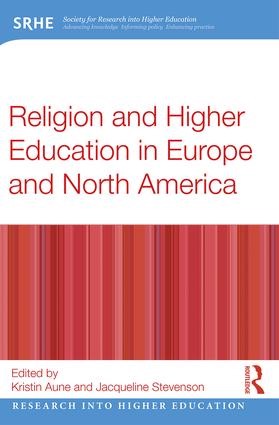
Religion and Higher Education in Europe and North America
Date Reviewed: December 12, 2017
When I arrived on campus as a first-year student, I had the name of an economics professor to track down, given to me by close church friends who knew that he and his wife belonged to a church in my new college town. When I knocked on his office door, he was both delighted and surprised; “I assumed you’d come about enrollment in my seminar. No student has ever asked me about church.” Four years later, he celebrated my graduation with other members of the church I’d faithfully attended. Admittedly, I was an outlier. But my story helps dispel the myth that college is a place to go to lose your faith.
Widespread assumptions hold that campuses are secularized spaces where religion surfaces only when it becomes a threat (“Fundamentalist students might endanger others”) or a nuisance (“Religious minorities might protest intolerance”). Contributors to Religion and Higher Education in Europe and North America argue that ordinary, everyday religious experience on campus is more common, less problematic, and more nuanced than many realize. Editors Aune and Stevenson collected thirteen essays by researchers and theorists representing different disciplines and approaches who are all curious about how students negotiate the university environment.
Section One shares findings from survey research demonstrating, for example, that when it comes to retaining their religious affiliations, practices, and beliefs, students differ from non-students of the same age only in identifying even more strongly with mainstream religious institutions upon graduation, and in shedding their belief in miracles. Other research shows that all groups, including the ‘nones,’ encounter campus climates hostile to their worldviews. This section tries to render empirical the question of secularization and higher education. It affirms both that religion is a slippery thing to measure and that more research is necessary.
Section Two presents qualitative research into the experience of being religious in ostensibly secular British, French, and Canadian universities. It challenges the idea that as a pluralistic, secular ethos grows at the institutional level, loss of faith results at the personal level. Becoming friendly to students’ faith would mean, among other things, ceasing to bracket religion as something purely private and propositional, moving beyond mere tolerance and accommodation toward formation of the whole person, expanding vocabulary beyond the moderate/radical binary (Islam), and creating safe and inclusive space for all.
Section Three argues for evidence-based institutional policies that treat religion as a social practice rather than an identity characteristic. One chapter addresses the relationship of religiosity to teaching and learning. Contributors call upon institutions of higher education to promote literacy, connection, and dialogue with respect to religion rather than continuing to fall back on the impersonal, secular, and reductionist norms of civility and free speech. In other words, secularity is not neutrality, and the college or university is not ultimately an arbiter of conflict but rather a pedagogical community.
This thought-provoking volume, which deliberately addresses higher education outside the United States, will interest several audiences, including campus life personnel, sociologists of religion, chaplains, teachers, and administrators